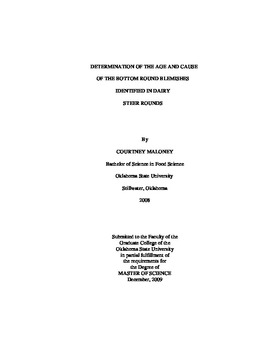| dc.contributor.advisor | Hilton, Gretchen G. | |
| dc.contributor.author | Maloney, Courtney Catherine | |
| dc.date.accessioned | 2014-04-15T20:12:57Z | |
| dc.date.available | 2014-04-15T20:12:57Z | |
| dc.date.issued | 2009-12-01 | |
| dc.identifier.uri | https://hdl.handle.net/11244/8840 | |
| dc.description.abstract | Several meat packers have identified scarring in bottom rounds of dairy steers. This is a major concern because of the decrease in tenderness and consumer acceptability caused by injection-site lesions. The objective of this study was to differentiate the regularity and severity of bottom round blemishes identified in dairy steer rounds. Holstein calves (n = 30) were selected and divided into three harvest groups. Calves from each harvest group were randomly sub-divided into treatment groups neck injection (CON; n = 5 per harvest group) and bottom round injection (BRI; n = 5 per harvest group). Harvest group 1 was fed for 25 d, representing pre-weaning; harvest group 2 was fed for 59 d, representing milk weaning; finally, harvest group 3 was fed for 398 d or market weight. Control calves received an injection on the right side in the neck, and BRI calves received the same adjuvant, also on the right side, in the bottom round. Carcass rounds were fabricated to IMPS #158 (NAMP, 2006) and evaluated for visual identification of lesions, and two 2.5 cm cutlets IMPS #1170A (NAMP, 2006) were identified for WBS value determination. Visual identification of injection-site lesions was higher (P < 0.05) in cutlets from BRI cattle than CON cattle from harvest group one. However, there was no difference in identification of injection-site lesions from BRI compared to CON for harvest groups two or three. Treatment had no effect on WBS value within each harvest group. Warner-Bratzler shear values were not affected by evidence of a visually identified injection-site lesion in cutlets from harvest group one, two, or three. Overall, BRI treatment does not have a significant impact on lesion presence or WBS values. Additionally, lesion presence does not have a significant impact on WBS values. Further investigation should be conducted utilizing calves from multiple farms and focusing on handling practices to determine the cause of bottom round lesion. | |
| dc.format | application/pdf | |
| dc.language | en_US | |
| dc.publisher | Oklahoma State University | |
| dc.rights | Copyright is held by the author who has granted the Oklahoma State University Library the non-exclusive right to share this material in its institutional repository. Contact Digital Library Services at lib-dls@okstate.edu or 405-744-9161 for the permission policy on the use, reproduction or distribution of this material. | |
| dc.title | Determnation of the Age and Cause of the Bottom Round Blemishes Identified in Dairy Steer Rounds | |
| dc.type | text | |
| dc.contributor.committeeMember | Vanoverbeke, Deb L. | |
| dc.contributor.committeeMember | Morgan, James Brad | |
| osu.filename | Maloney_okstate_0664M_10625.pdf | |
| osu.college | Agricultural Sciences and Natural Resources | |
| osu.accesstype | Open Access | |
| dc.description.department | Department of Animal Science | |
| dc.type.genre | Thesis | |
| dc.subject.keywords | blemish | |
| dc.subject.keywords | bottom round | |
| dc.subject.keywords | dairy beef | |
| dc.subject.keywords | lesion | |
